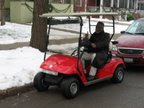Gas/Electric Solar1 $/Mile $ 0.09 - 0.20 $ 0.00
2 Purchase Cost $ 20 - 30,000 $ 5 - 7,000
3 Job Creation International Local
4 Maintenance Complex Simple
5 Safe Max Driving Same as today? Longer
6 Emissions Yes* No
7 Foreign Oil Dependency Yes No
8 Bio-Fuel Dependency Yes No
9 CO2 Emissions Yes* No
10 Safety - Compared to Safer Safer
2-Wheeled Vehicles
11 Other Uses - Short Rental
Gov't/Security
Education
Recreation
12 Other Benefits - Reduced
Parking
*From vehicle and/or Electrical Powerpoint
This chart compares various characteristics of a solar powered vehicle compared to a conventional gas and/or electric vehicle and illustrates why we believe that Solar Poered Neigborhood Vehicles will help make the transistion to "Neighborhood Vehicles". 1) The estimated operating cost for just gasoline alone based on $4.00/gal and 20-45 mpg for city driving is $0.09 - 0.20 per mile compared to no energy cost for a solar poered vehicle. 2) Due to the reduced size, weight and complexity, the initial purchase cost of a Solar vehicle on a "golf cart" platform is a fraction of the cost of a typical passenger car today. 3) More and more cars are foreign imports which eliminate local jobs. Because, in the State of Illinois, the neighborhood vehicle requires local authorization, it will encourage local business opportunies (more about this later). 4) The relative simplicity of the "golf cart" platform will reduce maintenance costs and make "do-it-yourself" maintenance one again possible. 5) The lower weight and speed will reduce the risk of injury to others allowing elderly drivers to drive at a more advanced age. This is based on the assumption that the fear of allowing some elderly people to drive is not just the potential of being injured themselves, but also the potential of injury or death to others, especially someone much younger. 6) Any concerns about emissions into the government are eliminated from the vehicle and at the electrical power generating power plant, whether gaseous, noise, or radioactive. 7) Reduction of the need for fuels derived from oil, reduces the demand on foreign oil and the various distribution channels. 8) Reduction of CO2 emission will reduce global warming due to greenhouse gases. Note: Non-solar electric cars often simply shift the source of CO2 emissions to the coal-fired electrical power generating plant. 10) Neighborhood Vehicles are safer than alternative highly energy efficient 2-wheeled vehicles like motor bikes, motor scooters, Segway's, etc. that are starting to pop up due to the skyrocketing gas prices. Neighborhood vehicles also offer more protection from the weather and have better passenger and cargo carrying capacity than two-wheeled vehicles. 11) Other Uses: 11a) Many cities have "Swipe and Go" transportation systems where a computer simply swipes a credit card, drives the vehicle for as long as they need, re-swipes the credit card, and is charged for the usage. 11b) Many government facilities, security agencies, and universities use "golf cart" type vehicles on the facility property. The authorization of Neighborhood Vehicles would extend the usage beyond the borders of the facilities. 11c) The relative simplicity yet timely appropiateness of Solar Powered Neighborhood Vehicles can function as an excellent educational tool at all levels of the education system. 11d) Did I mention that Neighborhood Vehicles based on a "golf cart" platform can also be used to play golf, as well as an easily trailer-able second vehicle on vacations. 12) Approximately four (4) "golf cart" type Neighborhood Vehicles take the same space as one (1) minivan which significantly reduces the parking space required per vehicle.



